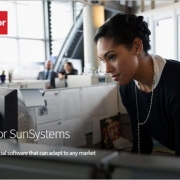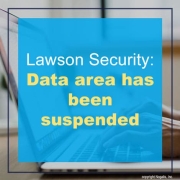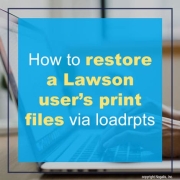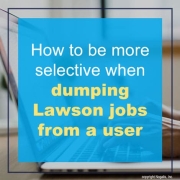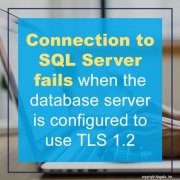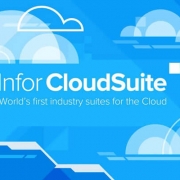Infor recently announced that independent energy company Gulfsands has deployed Infor SunSystems Cloud as its financial platform via Infor Gold Channel Partner Progressive TSL. Gulfsands is already seeing increased security, reduced risk, and improved functionality and performance. Per the press release, with a multi-tenant model, the smaller IT footprint will minimize administration and task duplication, enabling easier, more consistent access across the world, and a sharper, more-informed focus on its core business goals. It also eliminates the environmental impacts of maintaining an in-house IT infrastructure. Gulfsands, being London based and with recent openings in Abu Dhabi, UAE, opted for a cloud deployment to take advantage of having no physical servers, with reduced risk, cost and improved security as a result, as well as the updated functionality and capabilities in the latest version of SunSystems. Further, the cloud delivers a much easier way of supporting an increasingly dispersed workforce, as users can now access the system seamlessly from wherever they are in the world, which will be a huge benefit as the company scales.
Problem:
When I try to access or add a rule to a security class in the Lawson Security Administrator (LSA), I get the error message, “Data area has been suspended”. How do I resolve this issue?
Resolution:
This error usually occurs after running dbreorg without stopping your LSF WebSphere Application Server prior to the execution of dbreorg. This is a simple fix.
Basic steps to resolve this issue:
- First, we need to stop WebSphere
- Next, stop LSF
- From here, you must make sure that there are no java processes running. This is important so you won’t get the same error message again.
- After confirming, then you can re-start LSF
- Finally, start WebSphere again. You shouldn’t get the error message anymore.
LNS, the world leader in peripherals and services for machine tools, recently opted to deploy Infor M3 CloudSuite, an enterprise resource planning (ERP) solution powered by Amazon Web services (AWAS) that is specifically designed for manufacturers and distributors of products and after-sales services. A 15-year customer of Infor, this latest project is part of the company’s wider digital transformation plan and aims to achieve greater standardization at a global level to improve the quality of work, optimize access to information and improve collaboration between users. “As we prepare to switch to the multi-tenant cloud, our objective is to rewrite our processes entirely to simplify, standardize and industrialize them, and thus promote collaboration and exchange between our employees worldwide,” says Stéphane Englert, CIO of LNS. Per the press release, Infor M3 CloudSuite is the backbone of LNS’ information system and manages most of its main functions (purchasing, production, logistics, sales and finance). Additionally, the company has developed, often at the request of its users, some 30 internal applications designed to simplify their work. Englert adds, “We have high expectations of this project, the main objective of which is to have common tools interfaced with our different websites, in order to facilitate the exchange of data between our different sites and employees.” A go-live is expected by October 2024.
In Lawson, to restore a user’s print files, copy them to their original locations so that they will be visible in the print manager.
The standard locations for print files are:
Example (UNIX):
$LAWDIR/print/UserName/cu201b/1
Example (IBM i)
$LAWDIR/print/UserName/cu201b/1/xxxxxxx
Example (Windows):
%LAWDIR%\print\MYDOMAIN_UserName\cu201b\1
Once the files are copied to the correct directories, load them using loadrpts.
Running the command as follows will load all print files into the print manager for files existing in the standard print directories for all users where the file name in the directory ends with .prt:
loadrpts -s -p productline
To load reports for just one user from the standard print directory for files ending in .prt, use this syntax:
loadrpts -s -u username -p productline
Good luck!
Starting a business in today’s standards requires far more steps than it did just a decade ago. From hiring to point of sales systems to security, there are so many moving parts with each one critical to your operational success. Thankfully, with the technology and many options to choose from, you can run your business with ease. Levi Lapp, founder and CEO of Atlantic Outdoors, shares an article on Forbes of the technological offerings he found useful when starting his own business and how they can improve your business operations.
Hiring. “Once your business takes off, you need to hire employees. But just putting an ad in the paper isn’t enough anymore. Many online tools can help you post an available position, but what do you do when you have multiple candidates who interview well and have impressive resumes? There are now online tools that can help you choose between good candidates and great ones.”
Cybersecurity. “Ensuring your employees’ social security numbers or customer information is protected is critical. With proper data security in place, your technology tools and systems are more likely to be safe from digital attacks. As our business is growing and we’re hiring more people, it has been critical for us to focus on some of the basics, such as including firewall security to protect our website, WiFi network and internet connection. Another big one: maintaining control of any devices we provide to our employees.”
Customer Relationship Management (CRM). “CRMs serve as a client contact database and can keep track of all communications, including adding reminders about when to contact customers. With the correct data, some can even offer potential outcomes based on the information provided. These outcomes can help your team determine if a lead is worth the time and effort needed. Most CRMs also include calendar features that allow you to prioritize projects, schedule deadlines and even factor in personal time off and holidays. You can input your events with reminder notifications to keep you on track for meetings, appointments and other important dates.”
Business Travel. “If you need to go out of town for work, the high-tech world has come a long way for business travelers. Some of those common travel stressors like finding a place to work out or a healthy lunch spot can now be a thing of the past with informational apps powered by businesses like ClassPass and TripAdvisor. And how about returning to the office with all those receipts from the road? Not to worry. Apps like Expensify and TripIt can help you streamline your itinerary, expenses, miles and more.”
Running a business in the modern age still comes with its challenges. But thanks to many advancements in technology, we can still manage and run our businesses smoothly,
With growing technology means growing companies. The hot topic today is moving to the cloud. The latest trend with this is adopting a multicloud strategy, a move that comes with multiples benefits – if done right of course. There are challenges involved in a multicloud strategy, but none that cannot be tackled head on to prevent future issues. Member of the Forbes Technology council share some of the challenges that can come with managing a multicloud strategy, with advice on how to help businesses through each issue to ensure multicloud success.
- Managing Data Security And Compliance. “One challenge in managing workloads across multiple cloud environments is ensuring data security and compliance. Businesses can prepare for this by implementing robust security policies, utilizing encryption and access control measures and conducting regular audits to ensure adherence to industry standards and regulatory requirements.” – Remo Peduzzi, ICR Informatik AG
- Avoiding Data Fragmentation. “In today’s business landscape, scaling your company naturally leads to an increase in the amount of data generated, processed and stored, making cloud environments a necessity. However, this growth in data can result in fragmentation, making it crucial to take control of your data through automation and standardization before it becomes unmanageable.” – Daniel Korogodski, First Bridge
- Ensuring Reliable Tenant Access And Resource Security. “Leveraging cloud technology across multiple cloud environments will enable business continuity in the event of downtime in any one of the environments. Two of the challenges l see will be maintaining access to the tenants and possible security issues. To prepare for this change, businesses should ensure that tenant access and resources within multiple cloud environments are adequately secured.” – Nihinlola Adeyemi, ErrandPay Limited
- Ensuring Integration And Compatibility Between Different Platforms. “Ensuring seamless integration and compatibility between different cloud platforms is an understated challenge. With the increasing popularity of multicloud and hybrid cloud strategies, businesses may find themselves using multiple cloud providers, each with its own set of tools, APIs and interfaces—blending all of them is a gargantuan engineering hurdle in itself.” – Prashanth Balasubramanian, Striga
- Getting The Most Out Of A Multicloud Strategy. “Taking cloud-native approaches to developing applications and incorporating good design principles from the beginning can help companies make the most of multicloud services. Instead of focusing on managing workloads, it is better to design applications to take full advantage of the capabilities of cloud services. Embracing containerization through infrastructure as a service instead of traditional workload management can be beneficial when serverless architectures are not suitable.” – Brad Mallard, Version 1
- Monitoring Permissions. “In my experience, basic controls are still an issue for many cloud deployments. Monitoring permissions for corporate data stored in AWS, Azure and other platforms is a fundamental control that is often reviewed only annually. This leaves corporate data at risk if permissions are not set correctly.” – John Bruggeman, CBTS
- Managing FinOps. “Organizations are on multicloud platforms to avoid vendor lock-in or to manage business demands (or sometimes even by accident). Whatever the reasons for a multicloud strategy might be, FinOps—matching the available cloud budget with costs across the divisions within an organization—is the pinnacle of all the multicloud challenges organizations face. CFOs often lack a real-time, “single pane of glass” view of the budget versus spending trends across cloud platforms.” – Srini Gajula, Sage IT INC
- Controlling The Cost And Complexity Of Collaboration. “One problem with multicloud setups is the cost and complexity of making them work together. Many providers make it prohibitively expensive to move data out of their clouds. In such cases, multicloud setups are not truly multicloud, as people are unable to take advantage of what each cloud offers. This makes simplicity, support, documentation and an open platform important, particularly for startups.” – Yancey Spruill, DigitalOcean
- Balancing Cost And Carbon Optimization. “One challenge that comes with a multicloud strategy is trying to balance minimizing costs and carbon optimization. The pace of change and agility demands faster analysis of where to place a workload to minimize both the cost and the carbon footprint.” – Travis Greene, Micro Focus
- Supporting Both On-Premises And Cloud Applications. “We’re witnessing fragmentation across the data landscape in terms of technologies, vendors and use cases. Organizations can’t operate in silos anymore; we have to be ready to support applications that are hosted both on-premises and in the cloud. Only with common tools and approaches will we see the efficiency gains this offers, allowing us to improve productivity and spend more time creating value.” – Jakub Lamik, Redgate Software
- Auditing Infrastructure Security. “When data is scattered across multiple clouds, it is vulnerable to data breaches. As cloud providers constantly add new features to meet customer needs, IT teams must continuously audit and manage their infrastructure to ensure their cloud environments meet security requirements. Some best practices include strong encryption and automated monitoring tools to simplify the audit process.” – Parvinder Walia, ESET
- Coping With Increased Security Complexity. “While a multicloud strategy comes with many benefits in terms of the ability to use the best cloud service provider for the workload, technology and cost, it increases complexity in terms of security. Since each cloud platform is different, cloud defenders need to learn multiple technologies, and they often end up using separate security tools for each provider, complicating policy alignment and increasing workloads.” – Avi Shua, Orca Security
- Managing Machine Identities. “Managing machine identities is a significant challenge for multicloud environments. Modern workloads driven by DevOps, containerization or Internet of Things devices often require an extremely large number of machine identities in the form of digital certificates or keys. Without robust management, oversight and automation, outages, security problems or even breaches can occur.” – Ted Shorter, Keyfactor
- Optimizing For The Strengths Of Different CSPs. “Companies using multicloud strategies or delivering cloud-native technologies must be thoughtful in optimizing for the strengths of different cloud providers, seeking out the best models for data storage, GPU performance, tightest integration with end-user suites and, of course, support for security capabilities and tools. There are differences, and prioritizing usage based on need is critical.” – Devin Redmond, Theta Lake
- Overcoming Data Gravity. “Data gravity is the newest challenge. It can make moving data between cloud providers difficult, leading to delays and complexity in workload management. By building microservices with high availability in each cloud environment, businesses can optimize data processing and storage for each environment, reducing the need for data movement.” – Darren Person, Circana
- Codifying Infrastructure. “As cloud environments grow more complex, infrastructure as code becomes more and more important. Codifying your infrastructure means you can tear an environment down and spin the entire thing back up with the click of a button. By codifying your infrastructure now, you will position yourself well to manage workloads that span multiple cloud environments in a scalable and secure way.” – Tim Mitrovich, Artisan
- Managing Cognitive Load. “Cognitive load is becoming more of a challenge as the answer to every question continues to be “shift left.” Where will enterprises turn to find employees who can set up and secure networks while also writing code and managing deployed applications? Some estimates indicate that developers spend 20% of their time working on infrastructure rather than writing code that solves business problems.” – Rick Kilcoyne, CloudBolt Software
You might be used to copying all Lawson jobs from one user to another when provisioning new users because jobdump and jobload flags can be very confusing in Lawson.
Something like this:
jobdump -d -o Job -v UserName joesmoe jobdump.txt
then
jobload -c -o Job -v UserName <copy userid1> <to userid2> jobdump.txt
What if you only needed specific jobs from a user to copy over?
Lets say we only need to transfer a MA126 job called MA126M:
jobdump -d -o Job -v JobName MA126M -v UserName joesmoe jobdump.txt
Here is a AP155 Job named AP155_P1:
jobdump -d -o Job -v JobName AP155_P1 -v UserName joesmoe jobdump.txt
Remember the dump file will be in the path you’re currently in LID. Good luck!
Infor recently announced that AB Agri, a leading international agri-food business providing animal feeds and services, has chosen Infor CloudSuite Food & Beverage enterprise resource planning (ERP) solution, powered by Amazon Web Services (AWS), to digitally transform its global operation. Per the press release, AB Agri was concerned about the challenges caused by the variety of aging, highly-customized ERP systems in use across the business’s 11 brands and entities. “We were at the stage where our systems were slow and even unable to adapt to the changing needs of our business and our customers. We realized we weren’t leveraging the full potential of what an ERP solution could do for our business,” says Pascal Martel, AB Agri CIO. Choosing Infor checked off all the boxes for what they needed with a new and advanced ERP solution. With Infor’s CloudSuite Food & Beverage solution, Pascal notes, “We’re looking forward to seeing increased efficiencies right across the business, from more effective forecasting and operational planning, through to improved pricing and enhanced visibility, timeliness and accuracy of inventory.”
Problem:
When we try to connect to an SQL database with TLS1.2 on and TLS1.0 off, we get this error:
The test connection operation failed for data source x on server x at node <node> with the following exception:
java.sql.SQLException: The driver could not establish a secure connection to SQL Server by using Secure Sockets Layer (SSL) encryption.
Error: “SQL Server did not return a response. The connection has been closed.
ClientConnectionId:x”.
DSRA0010E: SQL State = 08S01, Error Code = 0. View JVM logs for further details.
Resolution:
TLS 1.2 and SQL Server require a fix from Microsoft to work.
To get the Content Store connection working:
– Ensure that the unrestricted jre policy files are added and in cognos configuration you add the SHA256 ciphersuites.
– Use the latest SQL Server jdbc driver (at least 7.0) for the java version that Cognos uses. You can find the latest SQL Server JDBC driver here: https://docs.microsoft.com/en-us/sql/connect/jdbc/download-microsoft-jdbc-driver-for-sql-server?view=sql-server-ver15
– Edit install_location\bin64\startwlp.bat (Windows) to add the following lines after the line set JVM_ARGS=-Xmx4096m -XX:MaxNewSize=2048m -XX:NewSize=1024m %DEBUG_OPTS%:
set JVM_ARGS=”-Dcom.ibm.jsse2.overrideDefaultTLS=true” %JVM_ARGS%
NOTE: The startwlp.bat file no longer exists in 11.1.5 and higher.
– Edit install_location\bin64\bootstrap_wlp_os_version.xml to add the following lines after the line <param condName=”${java_vendor}” condValue=”IBM”>-Xscmaxaot4m</param>:
<param>”-Dcom.ibm.jsse2.overrideDefaultTLS=true”</param>
– Edit install_location\bin64\cogconfig.bat (Windows) to add the following lines after the line set J_OPTS=%DD_OPTS% %J_OPTS%:
set J_OPTS=”-Dcom.ibm.jsse2.overrideDefaultTLS=true” %J_OPTS%
– If SQL Server has ‘Force Encryption’ set to ‘Yes’ (meaning that it is using an SSL certificate), you will need to import the SQL Server certificate into the Java cacerts keystore for your JRE. For example (using the Cognos JRE):
- Obtain the root Certificate Authority certificate that issued your SQL Server’s certificate (or the self-signed server certificate if it was not issued by a Certificate Authority), and copy to the computer where Cognos Analytics is installed. For example, copy the file sqlcert.cer to the root directory, c:\sqlcert.cer
- Type cd C:\Program Files\ibm\cognos\analytics\ibm-jre\jre\lib\security
- Type , for example, C:\Progra~1\ibm\cognos\analytics\ibm-jre\jre\bin\keytool -import -trustcacerts -file “c:\sqlcert.cer” -keystore cacerts -alias SQLCert
– Start Cognos Configuration using cogconfig.bat you modified in the previous step. Important: You must start IBM Cognos Configuration using cogconfig.bat
To get the SQL Server Native Client Connection:
Download a version of the Native Client that supports TLS 1.2 as per Microsoft’s KB Article: https://support.microsoft.com/en-ca/help/3135244/tls-1-2-support-for-microsoft-sql-server
To get the JDBC data source connection working:
– Go to Cognos Administration -> Configuration tab -> Dispatchers and Services
– Click on the dispatcher server to drill down to the services
– Beside the QueryService, click the Set Properties button
– Go to the Settings tab
– Add the following the Additional JVM Arguments for the QueryService setting
-Dcom.ibm.jsse2.overrideDefaultTLS=true
– Click OK
– Click on the Status tab
– Select System
– Click on the server to drill down to the services
– Beside QueryService, click the drop down arrow
– Select “Stop immediately”
– Wait 30 seconds for it to fully stop
– Click the drop down again and select “Start immediately”
You can also review the article from IBM:
Infor recently announced that Oliver Packaging & Equipment Co., a leading manufacturer of premium food equipment and meal packaging systems, is leveraging its integrated Infor CloudSuite Industrial and artificial intelligence (AI) solution to help provide critical food supplies to senior meals programs (including Meals on Wheels America), healthcare organizations, schools, grocery stores and more. Per the press release, Oliver Packaging integrated Infor Coleman AI services with Infor CloudSuite Industrial and implementing anomaly detection algorithms to identify abnormal customer orders and amounts quickly and more accurately. Further, daily processing of these anomalies, using machine learning, is delivered to the Oliver Packaging team in a user-friendly dashboard, where it reviews and analyzes the variances for sales and operations to make critical, real-time business decisions. Understanding their customers’ buying trends continually changing, Oliver Packaging knew there had to be a better way to detect these changes so that the right products were delivered at the right time — to improve the bottom line and customer experience.

